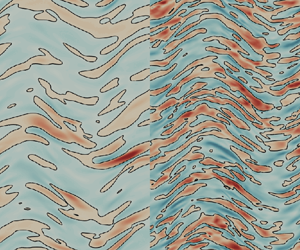Published online by Cambridge University Press: 21 May 2024

The ability of streamwise-travelling waves of spanwise velocity to reduce the turbulent skin-friction drag is assessed in the compressible regime. Direct numerical simulations are carried out to compare drag reduction in subsonic, transonic and supersonic channel flows. Compressibility improves the benefits of the travelling waves, in a way that depends on the control parameters: drag reduction becomes larger than the incompressible one for small frequencies and wavenumbers. However, the improvement depends on the specific procedure employed for comparison. When the Mach number is varied and, at the same time, wall friction is changed by the control, the bulk temperature in the flow can either evolve freely in time until the aerodynamic heating balances the heat flux at the walls, or be constrained such that a fixed percentage of kinetic energy is transformed into thermal energy. Physical arguments suggest that, in the present context, the latter approach should be preferred. This provides a test condition in which the wall-normal temperature profile more realistically mimics that in an external flow, and also leads to a much better scaling of the results, over both the Mach number and the control parameters. Under this comparison, drag reduction is only marginally improved by compressibility.